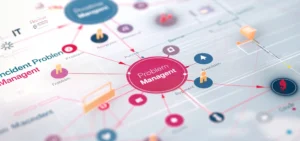How long does it take your IT service desk to resolve an incident?
It’s likely you can’t give a straightforward answer.
After all, your helpdesk workflow depends on a wide range of factors at any given time, including the volume of reported incidents, their severity, complexity and urgency, and the availability of the IT team.
So, how can you make order out of the chaos of incident management and optimize your IT service desk? With these 7 simple hacks, recommended by the IT Care Center experts:
1. Get assistance from automated chatbots
Over 13% of incidents are repeats, meaning that the helpdesk has already dealt with them before. The ITCC platform features a built-in chatbot that communicates with IT agents, providing real-time insights about how to resolve tickets. In other words, instead of “starting from scratch”, the helpdesk platform supports the IT team by drawing on previous experience, and presents practical, helpful information about the incident in an intuitive and conversational way.
Using an automated support chatbot to guide the agent can drastically speed up ticket resolution and improve on SLAs.
2. Use knowledge base suggestions
The average organization faces 1200 IT incidents a month, but only 5 of these are critical. Many incidents are simple or standard problems that don’t require IT expertise to resolve. Any incidents that end users can solve independently will free up time and resources, so that agents can focus their efforts on more serious and complex issues.
The ITCC platform includes a comprehensive Knowledge Management module that enables IT teams to offer a self-service knowledge base for end users, complete with an automated suggestion tool. When the end user creates an IT ticket, the system scans the keywords in the ticket and recommends relevant content from the knowledge base that may help the user solve the issue themselves.
If the user still needs the assistance of the IT agent, the ticket is assigned back to the team. These knowledge base suggestions can also be helpful for IT agents, enabling them to handle incidents independently without having to involve their team lead or manager.
3. Provide multiple channels for creating tickets
In 2024, the average employee relies on several devices and communication channels: laptop, desktop, mobile device, email, chat apps, and web conferencing. An effective incident management strategy will provide multiple ways for end users to create and submit tickets. IT Care Center, for example, supports IT ticketing via email, WhatsApp, chatbot, self-service portal, and MS Teams.
The goal is to provide a seamless UX that fits in with the workflows and routines of the end users. That’s also why ITCC is built with multi-language, multi-time zone functionality and a simple interface that is intuitive and easy to learn.
4. Leverage trends in IT incidents
While IT incidents come in all shapes and sizes, many are actually similar or related. Incidents often repeat, and good problem management can detect and resolve problems that cause incidents to reoccur.
A solid IT helpdesk platform can also leverage this phenomenon by picking up on trending categories and automatically generating templates for resolution of the most common incidents. These templates can be displayed in the self-service portal, where end users can readily access them and use them to fix common and recurring issues.
5. Automated, dynamic incident form submission
IT incidents are a drain on time and money. It is in everyone’s best interests to make the incident lifecycle as short and efficient as possible.
Submitting an IT ticket is the first part of the lifecycle that can be optimized to make better use of resources, especially since so much of an IT ticket is repetitive information. With the IT Care Center platform, incident forms change dynamically according to the selected category, drawing all corresponding information from the user submitting the ticket. While this saves just a few minutes of effort for each individual ticket, it adds up to a substantial saving of resources when considering the number of IT tickets and incidents that occur over time throughout the organization.
6. Automatic routing
Incident management is a balancing act: categorizing tickets, assessing urgency, and assigning them to IT agents. The ITCC IT service desk can do this automatically, based on predefined parameters appropriate for your organization and Service Level Management strategy.
Automatic routing is a powerful efficiency-boosting tool, acting as a traffic conductor that directs IT tickets to their next destination, without any manual input. Once the rules are set, the system automatically decides when and to whom to send the open ticket to ensure the best and fastest resolution. You decide the priority levels, urgency protocols and agent assignations, and let the system do the rest.
7. Escalation rules
IT incidents are dynamic. What starts out as a small issue can snowball to a major incident if it is not detected in time or managed properly. That’s where escalation rules come into the picture.
The IT service desk can be pre-set to automatically escalate incident resolution if certain milestones are not met. For example, if a ticket remains open after a predefined time, or if it fails to meet the SLA, or is about to exceed the SLA, it can be escalated to a higher priority status.
IT Care Center uses IT automation to trigger escalations in the service desk based on specified parameters. This is a very effective way to optimize helpdesk workflows and ensure that incidents are given the necessary attention at any given moment.
Making sense of the IT service desk with ITCC
In 2023, US-based companies were mostly able to contain cybersecurity incidents on the same day. However, full closure of the incident, including forensic analysis and reporting, took an average of 60 days.
Non-critical IT incidents may take longer to resolve, simply because serious incidents, such as cyber threats, are given higher priority. On the other hand, routine IT service desk requests, such as installing security updates or renewing software subscriptions, can and should be resolved quickly and even automatically, whenever possible. IT tickets that linger on ‘open’ status for too long are going to drag down your efficiency and SLA performance.
Incident management is dynamic, and it changes from moment to moment, day to day. At the same time, there are a lot of repeat incidents and discernible trends that can guide your ITSM towards efficiency. With IT Care Center and the simple tips recommended above, start optimizing your helpdesk and crushing your SLA goals even today.





